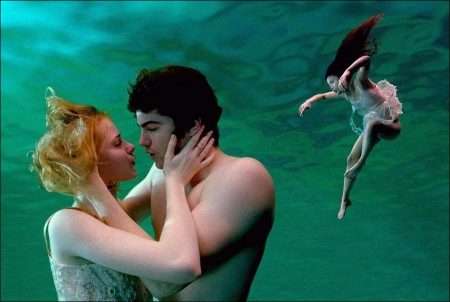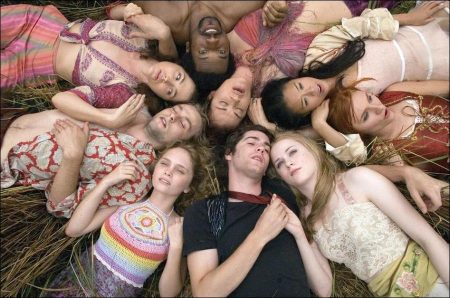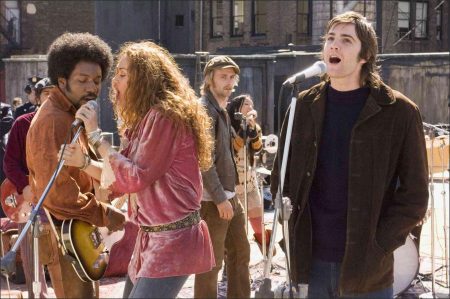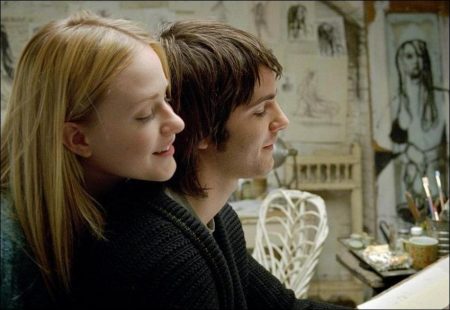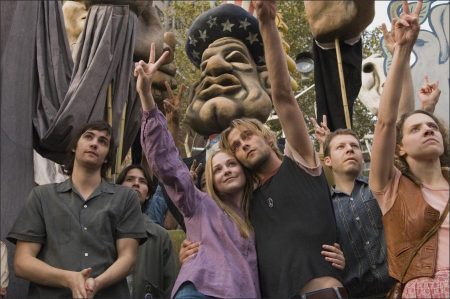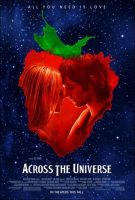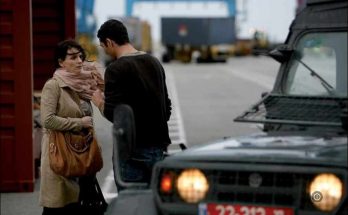Tagline: All you need is love.
Across the Universe movie storyline. At once gritty, whimsical and highly theatrical, Revolution Studios’ Across the Universe is a groundbreaking movie musical, springing from the imagination of renowned writer director Julie Taymor, and and writers Dick Clement & Ian La Frenais, that brings together an original story and 33 revolutionary songs – including “Hey Jude,” “I Am the Walrus,” and “All You Need is Love” – that defined a generation. Taymor says, “The idea was to create an original musical using only the songs of the Beatles.”
The film begins in an unspecified year of the 1960s with Jude, a young shipyard worker from Liverpool, reminiscing about a girl he once knew and loved on the Liverpudlian beach (“Girl”). A few months prior, Jude enlists in the Merchant Navy and jumps ship in New Jersey, hoping to find his American G.I. father, whom he has never met (“Hold Me Tight”, “All My Loving”).
eanwhile, Lucy Carrigan worries about her boyfriend Daniel who is headed for service in the Vietnam War; while in Dayton, Ohio, Prudence pines for a fellow female cheerleader (“I Want to Hold Your Hand”), and then drops out of school in shame. Jude meets his father, who is a janitor at Princeton University, and befriends Lucy’s brother, the privileged and rebellious student Max (“With a Little Help from My Friends”). Lucy receives a letter from Daniel (“It Won’t Be Long”), but when Max brings Jude home with him for Thanksgiving, Jude becomes attracted to Lucy (“I’ve Just Seen a Face”).
Max drops out of school and he and Jude move into a bohemian enclave in Greenwich Village, living with aspiring singer Sadie (Dana Fuchs). Meanwhile, after his younger brother is killed in the 1967 Detroit riot (“Let It Be”), guitar player Jojo goes to New York to pursue his passion (“Come Together”). While Jojo auditions for Sadie’s band, Max becomes a taxi driver and Jude finds work as a freelance artist. They are soon joined by Prudence, who has hitchhiked to New York and left an abusive boyfriend.
When Daniel is killed in Vietnam, Lucy decides to visit Max in New York before starting college (“Why Don’t We Do It in the Road?”). She and Jude fall in love (“If I Fell”), while Max is drafted into the army (“I Want You (She’s So Heavy)”). Prudence is attracted to Sadie, and becomes depressed when Sadie and Jojo begin a relationship. Prudence locks herself in a closet and has to be coaxed out of the closet (literally and figuratively) by her friends (“Dear Prudence”), then disappears after wandering off during a peace rally at which Paco, the leader of the Students for a Democratic Republic (SDR), is a speaker.
At a book function for existential drug guru Doctor Robert, Jude, Lucy, Jojo, Sadie and Max drink punch laced with LSD. They embark with Doctor Robert on his “Beyond” bus (“I Am the Walrus”), end up stranded outside the compound of a psychonaut, and see Mr. Kite’s bizarre circus where they are reunited with Prudence, who performs as Henry the Horse (“Being for the Benefit of Mr. Kite!”, “Because”).
Across the Universe is a 2007 British-American jukebox musical romantic drama film directed by Julie Taymor, centered on songs by the English rock band the Beatles. The script is based on an original story credited to Taymor, Dick Clement, and Ian La Frenais. It incorporates 34 compositions originally written by members of the Beatles. The film stars Jim Sturgess, Evan Rachel Wood, Joe Anderson and T.V. Carpio, and introduces Dana Fuchs and Martin Luther McCoy as actors. Cameo appearances are made by Bono, Eddie Izzard, Joe Cocker, and Salma Hayek, among others.
Reinterpreting the Songs
In addition to having a story that was layered enough to do justice to the songs, the other key element to the film was the musical interpretation, says Taymor. “It was really scary having the legacy of the Beatles’ music on your shoulders, because it’s the Holy Grail,” she says.
“It’s so important to so many people, and the originals were perfect. We knew from the beginning that we did not want to compete with the Beatles’ versions,” says Taymor. She felt that the best way to honor the band was to have their songs be the heart and the star of the film, emanating right from the characters.
To interpret the music, Taymor relied upon a trusted longtime collaborator, Elliot Goldenthal. “Though Elliot is a composer and there are no songs to be composed, his arrangements and his understanding of drama and character are so great. I’ve worked with him for twenty years and have total trust and admiration for his work. I knew that he would find a new way to interpret the songs; by placing them with new arrangements, the music would be fresh again – not a better version, but different.”
Goldenthal and Taymor also brought in renowned rock music producer T Bone Burnett and producer Teese Gohl, who has worked with Goldenthal as a music producer on more than 20 films. Goldenthal, Burnett, and Gohl collaborated on producing the music. Every song was analyzed: who would be singing, what was the content, the feeling needed from it in the film, and the time period.
Goldenthal notes, “Everybody knows the Beatles’ music so well, it’s almost like a ghost in the room. All the licks that they played, the specific guitar fills, the drum fills – everybody fills those in when they hear the songs. The songs were done perfectly already by the Beatles – they are definitive performances. So the challenge was try to find an honest way – staying within oneself – of getting to the core of these songs and try to find other ways to support the beautiful words.”
To give the music authenticity, the team recorded many of the songs using period appropriate equipment, such as analog tape and vintage microphones. Gohl recalls, “We were all on the same page in taking this approach and in our desire to avoid the digital pitfalls.”
As for working with the Goldenthal, Gohl says, “Elliot is unique in every sense, but to see him as a rock ‘n’ roll producer is yet another mind-blower.”
It was not enough, of course, merely to come up with new arrangements for the songs. Because the lyrics of the songs tell the story of the film, it was crucial to Taymor that the performances have immediacy and relevance to the scenes around them. With that goal in mind, the filmmakers decided to make the movie with as much live singing as possible. She gives credit to another one of her team members, sound mixer Tod Maitland, for making it work.
“He’s another genius,” says Taymor, because “most of the movie is live.” Maitland, who is a three-time Academy Award® nominee, had most recently worked on the more traditional movie musical The Producers, but Across the Universe would require an entirely different approach. He explains why such a radical move was necessary: “In most musicals, the actor speaks and then they go into a singing voice.
For most people, a singing voice is an entirely different voice – something they did in a studio two or three months earlier. It takes you out of the film. On Across the Universe, we wanted to keep the environment real. When you transition from speaking to singing, we want those moments to flow free, so that you don’t go in and out of different sound qualities – you want to stay in the scene. In addition, because the lyrics serve as dialogue in this movie, you want to hear the little bit of bounce off the walls, you want to hear people moving around. You don’t want a very closed-in, studio sound.”
The actors began the process by pre-recording their songs; these would to give them an idea of how their performance would go and provide a back-up for the editing process. In these sessions, the actors each performed the songs on three tracks: the first a studio microphone, the second a boom mike, like the one used on set, and the third a “lavalier” mike, also used on set.
During the shoot, the set would have to be extremely quiet to record a live vocal performance. The actors were all fitted with tiny ear pieces, called “earwigs,” to enable them to sing along with their pre-recorded performance. The pre-recorded track would give the actors a guideline to follow and allowed some freedom in the sound editing, according to Maitland. “If an actor turns his head away and goes off mike, we could pull in a vocal pre-record and lay that over. Or if there’s some noise over a take that the filmmakers really loved, we could go to a vocal pre-record.” However, he stresses, those are the exceptions. “The design of the whole film is to use live vocals as much as possible.”
The somewhat tricky process was made easier by the cinematographer, Bruno Delbonnel, and his lighting designer, John DeBlau, who consulted with the sound department when placing their lights, in order to help them to keep the boom microphone as close to the actors’ heads as possible. For the optimum result, the mike had to be only 12 to 15 inches from the actor, the same distance used in the prerecording sessions.
Continue Reading and View the Theatrical Trailer
Across the Universe (2007)
Directed by: Julie Taymor
Starring: Evan Rachel Wood, Jim Sturgess, Max Carrigan, Joe Anderson, Dana Fuchs, Martin Luther, T.V. Carpio, Spencer Liff, Lisa Hogg, Nicholas Lumley, Angela Mounsey, Michael Ryan
Screenplay by: Dick Clement, Ian La Frenais
Production Design by: Mark Friedberg
Cinematography by: Bruno Delbonnel
Film Editing by: Françoise Bonnot
Costume Design by: Albert Wolsky
Set Decoration by: Ellen Christiansen
Art Direction by: Peter Rogness
Music by: Elliot Goldenthal
MPAA Rating: PG-13 for some drug content, nudity, sexuality, violence.
Distributed by: Columbia Pictures
Release Date: September 21, 2007
Views: 166
